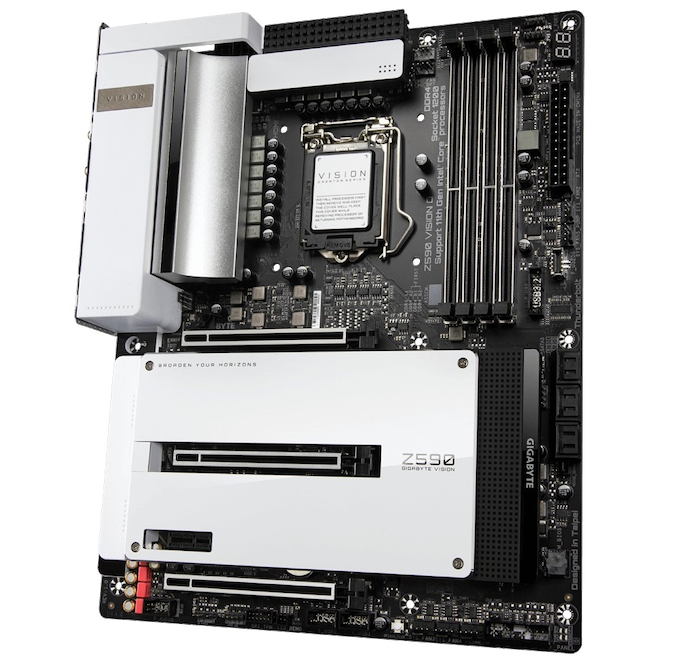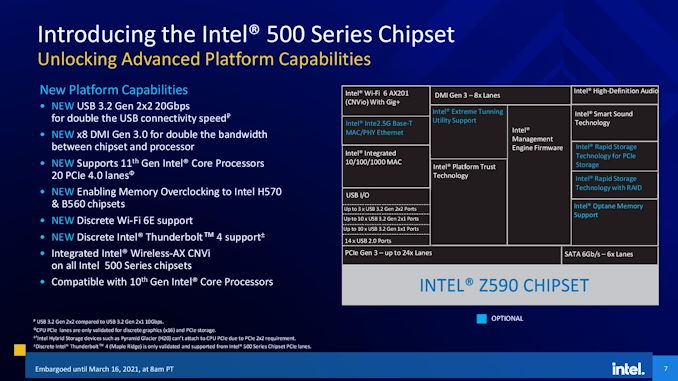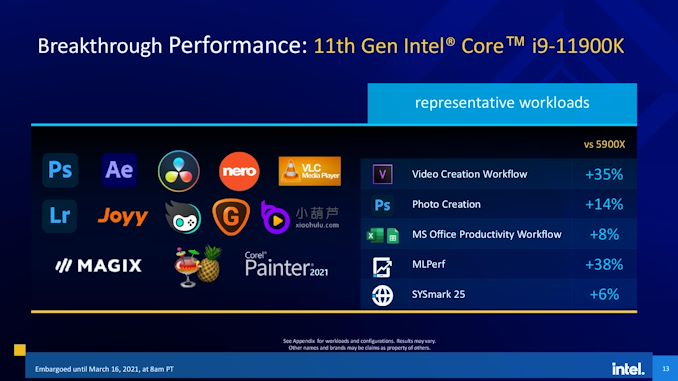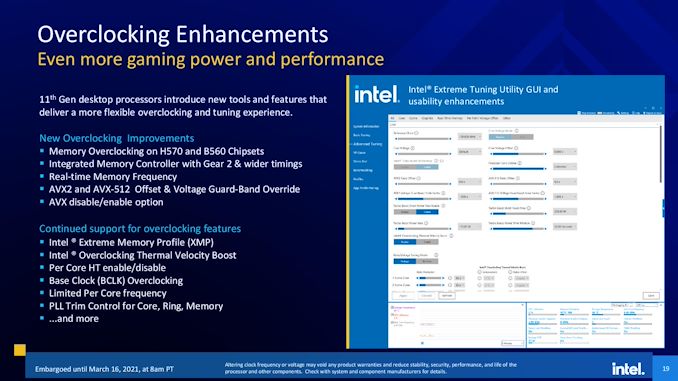Intel Launches Rocket Lake 11th Gen Core i9, Core i7, and Core i5
by Dr. Ian Cutress on March 16, 2021 11:00 AM ESTMotherboards and 500 Series Chipset
All of these new processors are LGA1200 processors, and a result they will be enabled in 500-series motherboards. There is also some 400-series support, however it depends on the platform. Here’s the trusty AnandTech Guide for support:
| Motherboard Support | |||
| AnandTech | B460 H410 |
Z490 Q470 H470 |
Z590 B560 H510 |
| Comet Lake | Yes | Yes | Yes |
| Rocket Lake | No | Yes | Yes |
The reason why Rocket Lake will not work in H410 or B460 motherboards is because these chipsets are built on Intel’s older 22nm process. There is something in the design of those chipsets, likely to be related to signal integrity, which means they cannot be supported, at least at the PCIe 3.0 speeds required. Given previous motherboard firmware, we might see unofficial support later down the line, even if only in PCIe 2.0 mode.
However, the lead platform for Rocket Lake will be the Z590 platform. We’ve already published a large overview of the 50+ motherboards on the market, but the new features boil down to:
- Double CPU-to-Chipset bandwidth when paired with 11th Gen RKL
- USB 3.2 Gen 2x2 (20 Gbps) native chipset connectivity
Here's the comparison of Z590 compared to the two previous generations of Intel high-end motherboards:
| Intel Z590, Z490, and Z390 Chipset Comparison | |||
| Feature | Z590 | Z490 | Z390 |
| Socket | LGA1200 | LGA1200 | LGA1151 |
| PCIe Lanes (CPU) | 20 | 16 | 16 |
| PCIe Specification (CPU) | 4.0 | 3.0* | 3.0 |
| PCIe Config | x16 x8/x8 x8/x8/x4+4 |
x16 x8/x8 x8/x8/+4 |
x16 x8/x8 x8/x4/+4 |
| DMI Lanes (3.0) | x8 (RKL) | x4 | x4 |
| Chipset PCIe 3.0 Lanes | 24 | 24 | 24 |
| Max USB 3.2 (Gen2/Gen1) | 6/10? | 6/10 | 6/10 |
| USB 3.2 Gen 2x2 (20 Gbps) | Y | ASMedia | N |
| Total USB | 14 | 14 | 14 |
| Max SATA Ports | 6 | 6 | 6 |
| Memory Channels (Dual) | 2/2 | 2/2 | 2/2 |
| Intel Optane Memory Support | Y | Y | Y |
| Intel Rapid Storage Technology (RST) | Y | Y | Y |
| Max Rapid Storage Technology Ports | ? | 3 | 3 |
| Integrated WiFi MAC | Wi-Fi 6 | Wi-Fi 6 | Wi-Fi 5 |
| Intel Smart Sound | Y | Y | Y |
| Integrated SDXC (SDA 3.0) Support | ? | ? | Y |
| Overclocking Support | Y | Y | Y |
| Intel vPro | N | N | N |
| Max HSIO Lanes | ? | 30 | 30 |
| ME Firmware | 15 | 14 | 12 |
| TDP (W) | 6 | 6 | 6 |
The new H570 and B560 motherboards reintroduce memory overclocking, a feature that was removed from the 400-series budget motherboards.
Here is the slide Intel provided for 500-series, though it is worth mentioning some of the caveats:
In this slide, it states that discrete Wi-Fi, 2.5 gigabit Ethernet, and Thunderbolt 4 are supported on 500 series. These are optional upgrades for the motherboard vendors, so not all motherboards will have them, and in each case they also require additional hardware costs for the motherboard manufacturer, such as an RF module for Wi-Fi, a PHY for Ethernet, or a PHY for Thunderbolt. These could all be added to any other motherboard, AMD or Intel, with discrete controllers which are slightly more expensive – those controllers don’t have to be Intel either. But to be clear, they are not unique to offerings to Z590, nor are they natively offered by default on all systems.
All of the 10th Generation Comet Lake processors will work in all 500-series motherboards, and get all the features, except the double CPU-to-Chipset bandwidth, as that specifically requires Z590 + 11th Gen Core CPU.
It should be noted that anyone already with a 400-series or 500-series motherboard, or those looking to purchase one, will need a BIOS update in order to enable the latest performance enhancements. In our testing, we found that the BIOS on our boards when they arrived in our offices were quite old (from January), and the latest microcode from Intel should help increase performance and cache latency. Some may be updated to February microcode, which does get most of the way there to peak performance, but the latest should always give the best results.
Performance and Overclocking Enhancements
For users looking for performance data, we have already reviewed a retail unit of the Core i7-11700K, and we thoroughly encourage you to check out that review. Intel’s own numbers for today’s launch use a variety of best-case scenario workloads that emphasize Intel’s internal accelerators rather than raw core performance – it should also be noted that Intel now considers MLPerf a ‘representative workload’, which is a far cry from the real world workload messaging we received only two generations ago.
On the Overclocking Enhancement side of things, this is perhaps where it gets a bit nuanced. For a while now Intel has been binning its K processors to within an inch of their maximum supported frequencies, and turbo boost techniques like favored core and Thermal Velocity Boost also push the margins on the cores that support it. So what can Intel focus on for overclocking this time round?
With Rocket Lake, Intel is leaning into the memory side of things. These new Rocket Lake processors now support geared ratios between the memory controller and the DRAM data rates. Traditionally on Intel these have operated on a 1:1 ratio, and in order to push that DDR4-5000 memory, like we did in our review of that premium Corsair kit, it required a processor with a good memory controller. With the 2:1 ratio, the memory controller will now operate at half speed, in a more comfortable zone, allowing memory overclockers to go beyond traditional limits – DDR4-5000 means that the memory controller is now only operating at 1250 MHz, rather than 2500 MHz (because DDR4 is measured in transfers per second, and there are two transfers per clock in Double Data Rate DDR memory). This also means that in order to match the internal clocks on DDR4-3200, users will have to start pushing the memory itself to DDR4-6400 to get the memory controller back on a level footing when in that 2:1 ratio. Nevertheless, this feature does allow the memory to be tested to its limits without the bottleneck of the CPU.
As mentioned in the previous page, Intel is going to use default gearing as a factor in product differentiation. The Core i9-K and i9-KF processors will officially support DDR4-3200 at 1:1, while all other CPUs support DDR4-3200 at 2:1. All CPUs will also support DDR4-2933 at 1:1. It should be noted however that motherboard manufacturers seem to be ignoring this - all the motherboards we have tested to date run at DDR4-3200 at Gear 1:1 regardless of the CPU. This is likely because the motherboard vendors feel confident in the ability of their products to enable 1:1 in all situations.
Also on memory overclocking, users that have tried this will note that in order to change the memory ratio, it requires a restart. With the new Z590 system, Intel has devised a system that will let a user select two different memory ratios, and it will enable both at boot time. Then, once in the operating system, a user can switch between them for different benchmarking modes. What this does is allow extreme overclockers, particularly those going for world records with sub-zero coolants, to boot at the lower memory speed, then run the test at a higher memory speed, then instantly revert back to the slow speed. Currently they have to run at the high speed all the time, which can be liable to instability. It’s more one for the extreme overclockers, but Intel has added it here.
Other new features in the overclocking toolkit include AVX-512 offsets and voltage guard bands, enabling users to overclock the processors without overclocking AVX-512 and incurring a heavy power consumption penalty. Intel has also put in an option to disable AVX altogether, which means that users who don’t want to worry about AVX-512 draining almost 300 W from an errantly loaded program, it can be disabled directly in the firmware.
Intel is also continuing support for a number of overclock-related features, such as per-core HyperThreading, per-core frequency adjustment, and fine-grained PLL controls. Intel has stated that with Rocket Lake, it has opened up some of the features to enable proper BCLK overclocking again, however we wait to see if there is a good range for overclockers to play with.
All these new features are enabled when a 500-series motherboard and a new Rocket Lake 11th Generation Core processor. Support with Comet Lake will be limited.
What Happens Now
Intel has officially confirmed to other press outlets on the record that retail of these processors will start on March 30th. Expect to see reviews of the top processors go live around the same time, or you can read our Core i7-11700K review today (because a retailer sold some early, and we got one to test).














156 Comments
View All Comments
TheinsanegamerN - Wednesday, March 17, 2021 - link
Just fine doesnt cut it, you need to keep it cool to get that 5.3 GHz, that mean sunder 70C. That means LOUD fans or an AIO to keep the temps down.abufrejoval - Tuesday, March 16, 2021 - link
You may well just run with 25-50Watts extra on your games, because those tend to stress your 300Watt GPU much more than your CPU cores.I had a Kaby Lake i3-7350K dual core running at 4.8GHz turbo next to ab E5-2696 v3 18 core Haswell running at 4GHz turbo: Guess who was faster in games but lost big time on CPU render benchmarks?
That was replaced eventually by a Ryzen 5800X which now delivers pretty much identical multi-core results as the Haswell Xeon and incidentally both use the same 110Watt of power. Only the Haswell chip is vastly bigger and would have cost 10x originally.
So even that 22nm 18 core Haswell still uses half the peak power of an i9-11700K, because it runs its 18 cores at only 2.7GHz, but it's still not a good gaming CPU.
And the 4.9GHz 5800X really isn't significantly faster than the Tiger Lake NUC with an i7-1165G7 on its top on any single core load, which run at 4.7GHz there for practically identical IPC and per-core TDP.
If yields and capacity for 10nm were plentiful, Rocket Lake would not exist.
But I have no doubt it will find willing buyers while the real environmental damage is much less than Bitcoin/Ethereal mining.
I'd guess that by the time enough games could use all 8 cores of Rocket Lake or Ryzen 3, the systems you built today will be out of date. In the mean-time their CPU power consumption will only be a small concern to the people who buy them.
Hossein - Tuesday, March 16, 2021 - link
Well, my 5950X has 5 cores boost to 5 GHz out of the box, with a max power usage of 135W. Idle, it consumes the same amount of power as my i7 6800K with 5 cores clock at 3.6 GHz and one core clocks at 3.8 GHz. In every usage like web browsing and watching YouTube, it actually consumes less power than the 6800K.yeeeeman - Tuesday, March 16, 2021 - link
This was actually demonstrated many times by both intel and amd. The last example of this was core 2 duo or sandy bridge vs bulldozer. Intel had to push these chips to 5ghz cause they really didn't have any other alternative.JayNor - Tuesday, March 16, 2021 - link
Intel also announced a couple of Cryo Cooling technology/Peltier heat sinks, if you're worried about the heat.I don't believe AMD made a choice to run at lower clock speeds ... just a matter of they didn't have a choice with the current TSM technology.
Qasar - Tuesday, March 16, 2021 - link
" Intel also announced a couple of Cryo Cooling technology/Peltier heat sinks " yea only because intel needs them to cool these power hungry hot cpus.Qasar - Tuesday, March 16, 2021 - link
JayNor, spoken like someone who either is paid by intel, or believes their PR bs.its obvious to most, that 10nm is not where intel needs its to be right now, and may never be. the only market intel can go after now is high midrange, or lower. rocket lake looks to be still a dud, even after all those pro intel fanboys that were crying about AT using an old microcode, so they updated with a new code, and it STILL didnt do what those same fanboys were saying it would. intel has no solid answer to zen 3 yet. instead, itel releases how many rocket lake skus ? 14 ???? that is crazy, and just confuses people. face it, no amount of PR from intel, is going to help, if amd was able to make enough zen 3 cpus, intel wouldnt be selling much, but intel is, only cause its all that is on the shelf. most i know, arent even looking at intel, and are waiting for zen 3.
damianrobertjones - Tuesday, March 16, 2021 - link
I like what you're saying, but capitals at the start of sentences would be amazing!JayNor - Tuesday, March 16, 2021 - link
Intel is sampling Alder Lake, Sapphire Rapids and Xe-HP 10nm parts, and has been shipping Tiger Lake, Ice Lake and P5900 family chips. It is time to lose the fantasy that Intel can't build 10nm parts.Qasar - Tuesday, March 16, 2021 - link
time to loose the fantasy that intel can build anything faster then what they have now, and that they dont use gobs of power. no matter how you spin it jaynor, rocket lake is a dud, 10 nm isnt shipping in anything meaningful, and only in low volumes